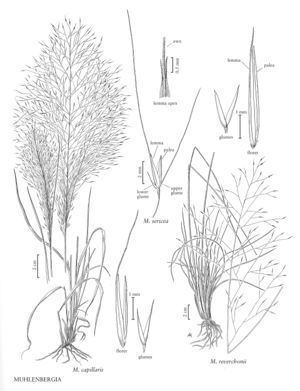Difference between revisions of "Muhlenbergia capillaris"
FNA>Volume Importer |
imported>Volume Importer |
||
| (2 intermediate revisions by the same user not shown) | |||
| Line 16: | Line 16: | ||
-->{{Treatment/Body | -->{{Treatment/Body | ||
| − | |distribution=Del.;D.C;W.Va.;Fla.;Puerto Rico;N.J.;Tex.;La.;Tenn.;N.Y.;Pa.;Va.;Ala.;Ark.;Ill.;Ga.;Ind.;Conn.;Md.;Kans.;Okla.;Mass.;Ohio;Mo.;Miss.;Ky.;N.C.;S.C. | + | |distribution=Del.;D.C.;W.Va.;Fla.;Puerto Rico;N.J.;Tex.;La.;Tenn.;N.Y.;Pa.;Va.;Ala.;Ark.;Ill.;Ga.;Ind.;Conn.;Md.;Kans.;Okla.;Mass.;Ohio;Mo.;Miss.;Ky.;N.C.;S.C. |
|discussion=<p>In the southeastern United States, <i>Muhlenbergia capillaris</i> usually grows in rocky or clay soils in open woodlands and savannahs and on calcareous outcrops, at elevations of 0-500 m. In the northeastern states, it is also found on diabase and sandstone outcrops and ridges. Its native range includes the southeastern United States, Bahamas, and possibly various Caribbean islands. It is also grown as an ornamental.</p><!-- | |discussion=<p>In the southeastern United States, <i>Muhlenbergia capillaris</i> usually grows in rocky or clay soils in open woodlands and savannahs and on calcareous outcrops, at elevations of 0-500 m. In the northeastern states, it is also found on diabase and sandstone outcrops and ridges. Its native range includes the southeastern United States, Bahamas, and possibly various Caribbean islands. It is also grown as an ornamental.</p><!-- | ||
--><p><i>Muhlenbergia capillaris</i> resembles <i>M. reverchonii</i> in many respects, but differs it is dull, apically scabrous lemmas.</p> | --><p><i>Muhlenbergia capillaris</i> resembles <i>M. reverchonii</i> in many respects, but differs it is dull, apically scabrous lemmas.</p> | ||
| Line 35: | Line 35: | ||
|illustrator=Linda A. Vorobik;Annaliese Miller | |illustrator=Linda A. Vorobik;Annaliese Miller | ||
|illustration copyright=Utah State University | |illustration copyright=Utah State University | ||
| − | |distribution=Del.;D.C;W.Va.;Fla.;Puerto Rico;N.J.;Tex.;La.;Tenn.;N.Y.;Pa.;Va.;Ala.;Ark.;Ill.;Ga.;Ind.;Conn.;Md.;Kans.;Okla.;Mass.;Ohio;Mo.;Miss.;Ky.;N.C.;S.C. | + | |distribution=Del.;D.C.;W.Va.;Fla.;Puerto Rico;N.J.;Tex.;La.;Tenn.;N.Y.;Pa.;Va.;Ala.;Ark.;Ill.;Ga.;Ind.;Conn.;Md.;Kans.;Okla.;Mass.;Ohio;Mo.;Miss.;Ky.;N.C.;S.C. |
|reference=None | |reference=None | ||
|publication title= | |publication title= | ||
|publication year= | |publication year= | ||
|special status= | |special status= | ||
| − | |source xml=https:// | + | |source xml=https://bitbucket.org/aafc-mbb/fna-data-curation/src/200273ad09963decb8fc72550212de541d86569d/coarse_grained_fna_xml/V25/V25_768.xml |
|subfamily=Poaceae subfam. Chloridoideae | |subfamily=Poaceae subfam. Chloridoideae | ||
|tribe=Poaceae tribe Cynodonteae | |tribe=Poaceae tribe Cynodonteae | ||
Latest revision as of 17:58, 11 May 2021
Plants perennial; cespitose, not rhizomatous. Culms 60-100 (150) cm, erect from the base, not conspicuously branched; internodes mostly glabrous, sometimes puberulent below the nodes. Sheaths glabrous or puberulent, basal sheaths rounded, often becoming fibrous, but never spirally coiled, at maturity; ligules 1.8-5(10) mm, membranous, firm, strongly decurrent, obtuse; blades 10-35(80) cm long, 2-4 mm wide, flat or involute, smooth abaxially, scabrous adaxially. Panicles 15-50(60) cm long, 5-30(41) cm wide, longer than wide, diffuse; primary branches 2-20 cm, capillary, diverging 30-100° from the rachises, naked basally, lower branches with 5-20 spikelets; pedicels 10-40(50) mm, longer than the spikelets, capillary, flexible. Spikelets 3-5 mm, usually purple, occasionally green, brown, or stramineous. Glumes subequal, (0.3)1-1.5(2) mm, usually less than 1/2 as long as the lemmas, glabrous; lower glumes 1-veined, usually unawned, rarely awned, awns 1-3 mm; upper glumes 1-veined, rarely 3-veined, acute to acuminate, often erose, usually unawned, rarely awned, awns 1-3(5) mm; lemmas 3-5 mm, lanceolate, not shiny, calluses shortly pubescent, apices scabrous, acuminate, sometimes with 2 setaceous teeth, teeth to 1 mm, unawned or awned, awns 2-13(18) mm, clearly demarcated from the lemma bodies; paleas 2-4.5 mm, lanceolate, acuminate, usually unawned; anthers 1.5-2 mm, purple. Caryopses 2-2.5 mm, narrowly elliptic, brownish. 2n = unknown.
Distribution
Del., D.C., W.Va., Fla., Puerto Rico, N.J., Tex., La., Tenn., N.Y., Pa., Va., Ala., Ark., Ill., Ga., Ind., Conn., Md., Kans., Okla., Mass., Ohio, Mo., Miss., Ky., N.C., S.C.
Discussion
In the southeastern United States, Muhlenbergia capillaris usually grows in rocky or clay soils in open woodlands and savannahs and on calcareous outcrops, at elevations of 0-500 m. In the northeastern states, it is also found on diabase and sandstone outcrops and ridges. Its native range includes the southeastern United States, Bahamas, and possibly various Caribbean islands. It is also grown as an ornamental.
Muhlenbergia capillaris resembles M. reverchonii in many respects, but differs it is dull, apically scabrous lemmas.
Selected References
None.
